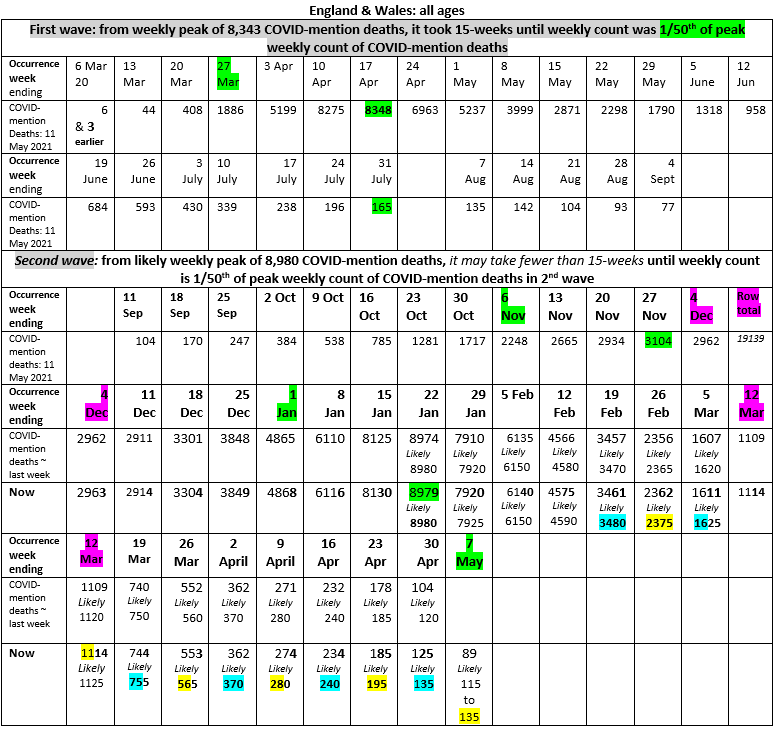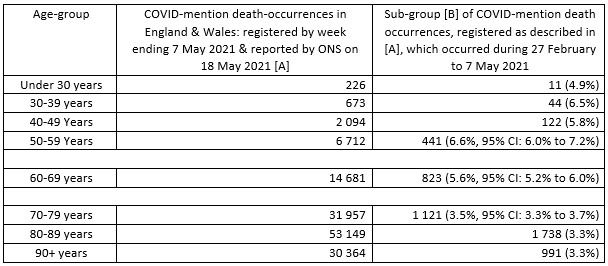The Office for National Statistics (ONS) have released provisional counts of the number of deaths registered in England and Wales in the week ending 7 May 2021.
Prof Sheila Bird, Formerly Programme Leader, MRC Biostatistics Unit, University of Cambridge, said:
“Provisional counts for COVID-mention deaths by date of occurrence are key data.
“Projecting forward a few weeks, it appeared likely that England & Wales will experience 86,000 (nearest 1000) COVID-mention deaths by the time that the weekly count of COVID-mention deaths is fewer than 1/50th of the peak count in Wave 2 of 8945 COVID-mention deaths. If so, then very sadly Wave 2 will have claimed 65% more lives than Wave 1.
“Wave 1 peak count was 8,348 COVID-mention deaths and it took 15 weeks until the Wave 1 weekly count dropped below 1/50th of Wave 1’s peak-count (i.e. below 167). Wave 2 is likely to achieve the corresponding goal in fewer than 15 weeks, but by one week only (i.e. in week ended 30 April 2021).
“My table shows COVID-mention deaths in England & Wales (by week of occurrence) in Wave 1 from early September 2020 to mid-April 2021. I use both a) the pattern of registration-delays and b) fortnightly rates of change in the occurrence of COVID-mention deaths to estimate likely totals for COVID-mention deaths in the most recent weeks of occurrence.
“In England and Wales, not all deaths which occurred in the week ending 7 May 2021 have yet been registered. Taking registration delay into account, we can expect that 115 to 135 COVID-mention deaths may have occurred in England & Wales in the week ended 30 April 2021, see Table. Fortnightly rates have long since switched from increasing to decreasing (most recent yellow; most recent turquoise).
“Expectation is that the Wave 2’s death-toll (that is: until COVID-mention deaths per week are below 1/50th of peak-occurrence-week) will be 72% higher in England & Wales at 90,000 (nearest 100) than the toll of COVID-mention deaths in Wave 1 (52,250).
“The corresponding Wave 2 estimate for Scotland (5,864) versus 4,213 in Wave 1 will be available tomorrow but the increase in Wave 2 versus Wave 1 is below 40%. Whereas Scotland’s peak weekly toll in Wave 1 was 645 (versus 490 in Wave 2), for England and Wales the two peak weekly tolls were 8,348 in wave 1 but higher still at 8,980 (expected) in wave 2. The Kent variant and slower lock-down around Christmas may be contributory factors: Scotland’s border closed on 26 December 2020.

Wave 1 to 31 July 2020 = 52,248 or 52,250 (nearest 50); there follows 5-week inter-regnum = 551
Wave 2: 5 Sept to 30 April 2021 = 89,814 (@ 11 May).
Wave 2 expectation is 90,000 (nearest 100) COVID-mention deaths until weekly count is below 1/50th peak count of COVID-mention deaths (180).
Hence, Wave 2 expectation is 72% higher death toll in England & Wales than in Wave 1.
“NB: Vaccine effectiveness in older age-groups may account, in part or whole, for the much lower percentage that recent COVID-mention deaths represent of all COVID-mention deaths by age-group.”

Prof Kevin McConway, Emeritus Professor of Applied Statistics, The Open University, said:
“The latest provisional weekly data from ONS on deaths registered in England and Wales covers the week from 1 to 7 May. In general terms, it continues the good news that we’ve seen for many weeks now. Registered deaths from all causes are down compared to the previous week overall, and separately in England, in Wales, in most of the English regions and in most age groups. Total registered deaths are below the average for the five years 2015-2019, as they have been every week since the middle of March, and that’s true for England and for Wales taken separately, and for every English region. The same pattern broadly applies to deaths where Covid-19 is mentioned on the death certificate. They are also down considerably for the latest week compared to the week before, overall, in England and in Wales separately, in all but one of the English regions, and in most age groups.
“The snag, however, is that there was a bank holiday on 3 May, and bank holidays affect death registrations because registration offices are closed and people are on holiday. So you’d expect numbers of registered deaths to fall quite a bit, compared to the previous week, just because of that. The bank holiday affects comparisons with the five year average too, because the bank holiday occurs in differently numbered weeks in different years. This makes it very difficult to look at short-term trends and to make meaningful comparisons with recent previous weeks. ONS also provide data on deaths classified by the date the death actually occurred, rather than when it was registered. But the numbers by date of occurrence of death for the week 1-7 May only include deaths registered up to 15 May, so the figures for recent weeks will be incomplete because deaths often take some time to be registered, and this particularly affects the most recent week. In future weekly data releases these counts by date of occurrence of death will be revised upwards as more registrations come in, so eventually we’ll have a much more complete picture – but not yet. So I’ll not comment any further on short-term trends. Next week’s data will clarify things a little, though the numbers then won’t be entirely typical either, because registrations delayed slightly from the week 1-7 May will probably mean that the number for the following week is a bit higher than it would be without the bank holiday.
“Given the concern about the Indian variant of concern, B.1.617.2, it’s worth mentioning that any deaths arising from the variant just won’t show up in this data release. Public Health England (PHE) have reported that, sadly, there have been four deaths due to this variant in England up to 12 May – I believe there have been no deaths involving the variant in Wales, where the variant has been detected in only very low numbers of cases. But four deaths would simply not show up in these data, on top of the normal level of statistical variability. Also, some or all of those four deaths might well have occurred after the period covered in the death registration data, which go up only to 7 May. Since it typically takes at least two weeks, and often longer, after someone is infected with the virus before they can become ill enough to die from it, deaths in the most recent week of ONS data would probably be of people infected in the week ending 23 April at latest. There were certainly infections with this variant detected before that, but only in small numbers. This ONS data release can’t tell us anything about the variant – it’s just too early.”
All our previous output on this subject can be seen at this weblink:
www.sciencemediacentre.org/tag/covid-19
Declared interests
Prof Kevin McConway: “I am a Trustee of the SMC and a member of its Advisory Committee. I am also a member of the Public Data Advisory Group, which provides expert advice to the Cabinet Office on aspects of public understanding of data during the pandemic. My quote above is in my capacity as an independent professional statistician.”
None others received.